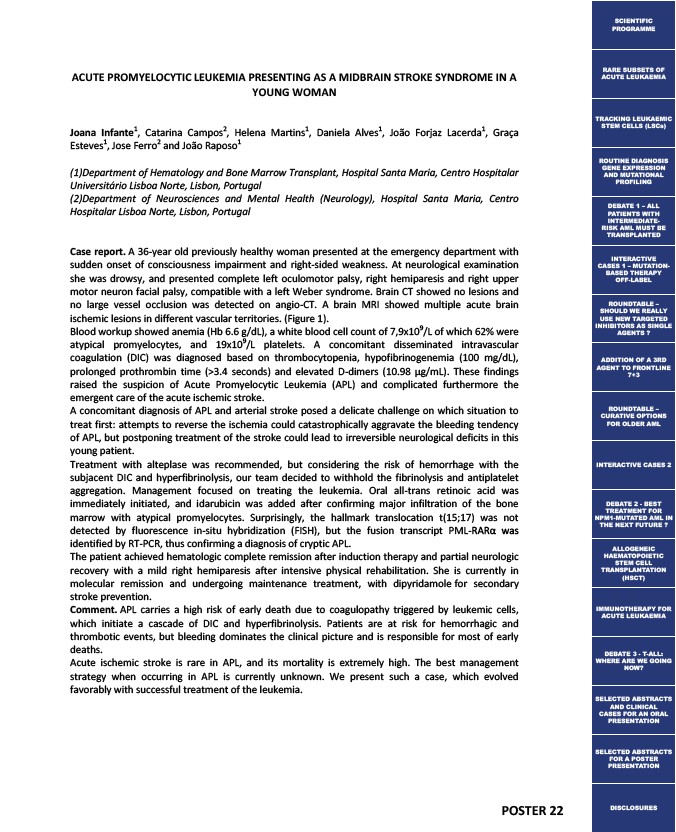
ACUTE PROMYELOCYTIC LEUKEMIA PRESENTING AS A MIDBRAIN STROKE SYNDROME IN A
POSTER 22
YOUNG WOMAN
Joana Infante1, Catarina Campos2, Helena Martins1, Daniela Alves1, João Forjaz Lacerda1, Graça
Esteves1, Jose Ferro2 and João Raposo1
(1)Department of Hematology and Bone Marrow Transplant, Hospital Santa Maria, Centro Hospitalar
Universitário Lisboa Norte, Lisbon, Portugal
(2)Department of Neurosciences and Mental Health (Neurology), Hospital Santa Maria, Centro
Hospitalar Lisboa Norte, Lisbon, Portugal
Case report. A 36-year old previously healthy woman presented at the emergency department with
sudden onset of consciousness impairment and right-sided weakness. At neurological examination
she was drowsy, and presented complete left oculomotor palsy, right hemiparesis and right upper
motor neuron facial palsy, compatible with a left Weber syndrome. Brain CT showed no lesions and
no large vessel occlusion was detected on angio-CT. A brain MRI showed multiple acute brain
ischemic lesions in different vascular territories. (Figure 1).
Blood workup showed anemia (Hb 6.6 g/dL), a white blood cell count of 7,9x109/L of which 62% were
atypical promyelocytes, and 19x109/L platelets. A concomitant disseminated intravascular
coagulation (DIC) was diagnosed based on thrombocytopenia, hypofibrinogenemia (100 mg/dL),
prolonged prothrombin time (>3.4 seconds) and elevated D-dimers (10.98 μg/mL). These findings
raised the suspicion of Acute Promyelocytic Leukemia (APL) and complicated furthermore the
emergent care of the acute ischemic stroke.
A concomitant diagnosis of APL and arterial stroke posed a delicate challenge on which situation to
treat first: attempts to reverse the ischemia could catastrophically aggravate the bleeding tendency
of APL, but postponing treatment of the stroke could lead to irreversible neurological deficits in this
young patient.
Treatment with alteplase was recommended, but considering the risk of hemorrhage with the
subjacent DIC and hyperfibrinolysis, our team decided to withhold the fibrinolysis and antiplatelet
aggregation. Management focused on treating the leukemia. Oral all-trans retinoic acid was
immediately initiated, and idarubicin was added after confirming major infiltration of the bone
marrow with atypical promyelocytes. Surprisingly, the hallmark translocation t(15;17) was not
detected by fluorescence in-situ hybridization (FISH), but the fusion transcript PML-RARα was
identified by RT-PCR, thus confirming a diagnosis of cryptic APL.
The patient achieved hematologic complete remission after induction therapy and partial neurologic
recovery with a mild right hemiparesis after intensive physical rehabilitation. She is currently in
molecular remission and undergoing maintenance treatment, with dipyridamole for secondary
stroke prevention.
Comment. APL carries a high risk of early death due to coagulopathy triggered by leukemic cells,
which initiate a cascade of DIC and hyperfibrinolysis. Patients are at risk for hemorrhagic and
thrombotic events, but bleeding dominates the clinical picture and is responsible for most of early
deaths.
Acute ischemic stroke is rare in APL, and its mortality is extremely high. The best management
strategy when occurring in APL is currently unknown. We present such a case, which evolved
favorably with successful treatment of the leukemia.
SCIENTIFIC
PROGRAMME
RARE SUBSETS OF
ACUTE LEUKAEMIA
TRACKING LEUKAEMIC
STEM CELLS (LSCs)
ROUTINE DIAGNOSIS
GENE EXPRESSION
AND MUTATIONAL
PROFILING
DEBATE 1 – ALL
PATIENTS WITH
INTERMEDIATE-RISK
AML MUST BE
TRANSPLANTED
INTERACTIVE
CASES 1 – MUTATION-BASED
THERAPY
OFF-LABEL
ROUNDTABLE –
SHOULD WE REALLY
USE NEW TARGETED
INHIBITORS AS SINGLE
AGENTS ?
ADDITION OF A 3RD
AGENT TO FRONTLINE
7+3
ROUNDTABLE –
CURATIVE OPTIONS
FOR OLDER AML
INTERACTIVE CASES 2
DEBATE 2 - BEST
TREATMENT FOR
NPM1-MUTATED AML IN
THE NEXT FUTURE ?
ALLOGENEIC
HAEMATOPOIETIC
STEM CELL
TRANSPLANTATION
(HSCT)
IMMUNOTHERAPY FOR
ACUTE LEUKAEMIA
DEBATE 3 - T-ALL:
WHERE ARE WE GOING
NOW?
SELECTED ABSTRACTS
AND CLINICAL
CASES FOR AN ORAL
PRESENTATION
SELECTED ABSTRACTS
FOR A POSTER
PRESENTATION
DISCLOSURES